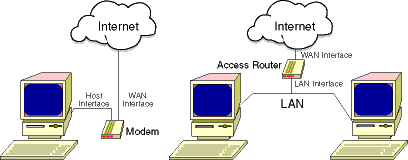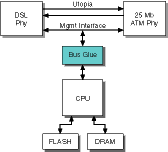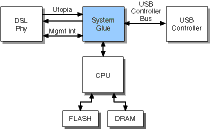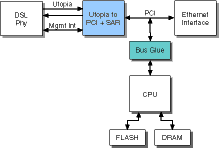
 |
|
Xilinx at Work in Digital Modems -
|
|
![]() To download a
.pdf copy of this White Paper, click here.
To download a
.pdf copy of this White Paper, click here.
IntroductionThis white paper gives an overview of digital modem technologies and how Xilinx high volume programmable devices can be used to implement complex system level glue in digital modem designs. The Xilinx device families targeted at these high volume applications include XC9500 CPLDs and Spartan FPGAs.The flow of this document will start with an overview of the various digital modem technologies and how the factors driving their deployment. We will next examine the major functional blocks of a digital modem and give an overview of the Application Specific Standard Products (ASSPs) that are used in each functional block. We will then illustrate the system level glue functions that are needed in several different digital modem configurations. While this document focuses on applications of these devices in digital modem applications, the examples discussed illustrate many of the issues found in other designs; specifically, how to cost effectively interface complex ASSPs with incompatible interfaces. The ASIC vendors have abandoned the traditional solution for this class of problems, the small ASIC, as they moved towards the system on chip market. Fortunately for system designers, new classes of low cost PLDs such as the Spartan family have filled this void with devices that replace low density ASICs and retain the time to market advantages of FPGAs. OverviewInternet users are continuing to demand higher bandwidth access to the net. Both a new class of corporate users and new services are driving this. Corporate users are being brought to the Internet as corporations begin to move away from their private networks. Many are using the Internet to connect remote offices and telecommuters to their corporate Local Area Networks (LANs) using Virtual Private Network (VPN) technologies. High bandwidth access to corporate resources is necessary to maintain the productivity of these remote workers.New Internet services coming online also benefit from a higher bandwidth connection to the user. Examples include streaming video that is an integral part of every online news service. Users of online shopping services need greater bandwidth to support the high-resolution images that make an online buying decision practical. In the face of this demand analog modem technology has hit the end of the road with the 56K generation of devices. Increasing Internet access bandwidth requires a migration to digital modem technologies. While there are numerous approaches being proposed including wireless and satellite technologies, it is generally accepted that the bulk of users will get their high bandwidth digital Internet access using either cable modem or Digital Subscriber Line (DSL) modem technologies. Cable modems offer data rates up to 10 Mbps with a caveat that will be described later. DSL technologies offer a variety of access rates up to 6 Mbps. ISDN was the original digital subscriber service. ISDN delivers up to 128 Kbps of bandwidth to the subscriber and supports both digital voice and data services simultaneously over the same line. ISDNOnce touted as the ultimate subscriber technology, ISDN has seen slow deployment until recently, due to lack of standardization and high cost. Most Regional Bell Operating Companies (RBOCs) deliver ISDN as a dial-up, metered service. This means that during business hours users are charged for each minute the ISDN connection is operating.ISDN has also lost a lot of its appeal as analog modems have reached the 56 Kbps level. Modem suppliers now provide software that lets users use two 56K modems as a single 112 Kbps connection, close to the data rate available from an ISDN connection. At the other end of the spectrum, DSL and cable modem services are delivering bandwidths that are an order of magnitude greater than ISDN. While ISDN will not be disappearing any time soon, all projections indicate that growth in the ISDN market is flattening. It is expected that ISDN will be relegated to applications where cable modem or DSL service is not available. Analysts indicate there are approximately 2 million ISDN lines deployed in the US. This represents approximately 1.1% of all lines. Cable ModemsCable modems use the same coaxial cable that is used deliver cable TV service to provide a connection to the Internet. Digital data is RF modulated and transmitted on 6 MHz channels reserved for data services.There are two standards for cable modems. In North America the Data Over
Cable Service Interface Specification (DOCSIS), developed by CableLabs In spite of the higher bandwidth that cable modems appear to offer over DSL technologies, there are some limitations to this technology. First the bandwidth is shared amongst users in a neighborhood. This is a result of the multidrop configuration of cable. This means that all of the homes in a neighborhood are effectively wired together and all see the same data. This has two implications. First the 10 Mbps of bandwidth that cable modems provide is shared amongst all of the users in a neighborhood. The second is that unless data is encrypted before it is transmitted, it is vulnerable to interception by other users. According to Gecko Research, 600,000 users in the U.S. are currently using cable modem services. This represents a penetration of 4% of the 15 million households that could subscribe. DSLDigital Subscriber Loop (DSL) technologies use the same twisted pair copper wiring that is used to for voice telephone service to deliver high speed digital data. In fact the same line that is used for DSL service can be used for voice service using a standard analog phone.Due to standardization issues DSL services have gotten off to a slow start. According to Gecko Research, there are currently 50,000 DSL service subscribers in the US This represents a meager .03% of the 177 million phone lines in the US However it is expected that DSL services will be rapidly rolled out over the next few years. DSL TechnologiesOnce again, lack of a unified standard has been a key issue that has slowed the deployment of DSL services. The range of technologies that have been deployed reflects the difficulty of the problem being solved. Table 1 compares several key characteristics for the more significant DSL variants.Table 1: DSL Technology Comparison
Driving high-speed data down copper pairs from a central office to a subscriber’s home requires sophisticated digital signal processing technology. The problem is compounded by the variances in line length, cross talk, wire gauge and other factors. In response to this the various DSL technologies that have appeared make different tradeoffs between data rate, the distance that data can be driven and complexity of the line-coding scheme used. Fortunately the key players have agreed now agreed on a common ADSL technology which is described in ANSI Standard T1.413, and is based on the Discrete Multi Tone (DMT) coding scheme. There are two variants of the DMT ADSL standard that are described in ITU standards G.992.1 and G.992.2. G.992.1 is the original full rate, 6.1 Mbps, specification. The problem with this standard is that it requires the installation of a "splitter" at the customer premises to support both voice and data over the same line. The G.992.2 (formerly known as G.Lite) was developed by Rockwell to eliminate the need for a splitter at the customer end of the line. The tradeoff for the simplified installation is a reduced data rate, 1.5 Mbps. Digital Modems Versus SOHO RoutersDigital modem technology can be packaged in either the traditional modem format or as a Small Office / Home Office (SOHO) router. Figure 1 illustrates how they are typically deployed.Figure 1: Application of Digital Modems and SOHO Routers
The figure on the left illustrates the use of a standard modem. A modem has two interfaces: a Wide Area Network (WAN) interface, connected to the phone line, and the host interface that is connected to a computer. Traditionally the host interface is a serial interface such as RS-232 or in the case of an internal modem the host interface is the computers I/O bus, usually ISA or PCI bus. In any case the function of the modem is to modulate and demodulate (hence the term modem) data for transmission across the WAN interface. The explosive growth of Local Area Networking has created a class of devices, targeted at SOHO applications that combine a modem with an Access Router. An access router is used to determine whether traffic on a local LAN segment needs to be forwarded to the WAN. SOHO routers also act as a network firewall; that is, they are used to keep hackers from accessing local systems via the Internet connection. SOHO routers typically look like external modems with an Ethernet connection rather than a host connection. In fact 3Com markets their SOHO access router products under the name "LAN Modem". The advantage of a SOHO router over a standard modem is that it lets multiple users share a single Internet connection. The increasing interest in home LAN technology is expected to increase the demand for this class of product. Digital Modem ArchitectureWhether the product is a cable modem, DSL modem, or SOHO router all of these digital modem products share the common functional blocks shown in Figure 2.Figure 2: Digital Modem Architecture
The functional blocks that make up the system are:
The following will examine how each of these functional blocks is implemented. Digital Modem WAN InterfacesWAN interfaces are implemented with specialized signal processing ASSPs, each of which has been targeted at a specific application. While there is talk of multifunction interfaces based on general-purpose programmable DSP technology, each interface currently requires a specialized chipset.Functions that are included in these interfaces include:
DSL ASSP ProvidersAlcatel dominates the market for DSL ASSPs with greater than 40% market share. This is a result of the fact that Alcatel is also the leading supplier of ADSL equipment.Manufacturers of DSL ASSPs are fiercely competing for this rapidly growing market. All of the players are working on next generation, cost reduced chipsets and keep most product information under NDA. T1.413 compliant solutions are available are available from Alcatel, TI, Analog Devices, Motorola, and Lucent. All of these devices with the exception of the Lucent offering can be used in either modem or central office applications. The Lucent WildWire chipset is targeted at the PCI add in card market and supports only G.992.2 (G.Lite) operation. Table 2 summarizes the available T1.413 compliant solutions. Table 2: DSL ASSPs
Cable Modem ASSP ProvidersBroadcom dominates the market for cable modem ASSPs. The only significant competition on the horizon is in the form of the Conexant CN9414 DOCSIS cable modem. This device includes not only the modem functions, but also a RISC microprocessor, USB, and Ethernet interfaces.Table 3: Cable Modem ASSPs
LAN InterfacesLAN interfaces are used on the local side of a SOHO router. This interface gives all users on the LAN access to the WAN connection.The most popular interface for this application is Ethernet; usually the 10 Mbps twisted pair version (10-BASET). You can also expect to see products being introduced that support the new Phone Networking Alliance (PNA) version of Ethernet. The PNA technology supports 1 or 10 Mbps Ethernet networking over existing phone wiring. Better yet, the technology supports the simultaneous use of the same wiring for phone service. Another network interface that has been used for first generation DSL modems is 25 Mbps ATM. Ethernet and or USB will likely replace this interface in next generation products. Token-Ring interfaces are found only on products targeted at corporate markets. LAN Interface ASSP ProvidersLAN interface ASSPs are targeted at the PC adapter card market. As a result virtually all include a PCI host interface. In addition software support comes in the form of drivers for PC operating systems.Currently a complete Ethernet interface solution consists of two chips; the interface controller commonly referred to by the term Medium Access Controller (MAC) and a physical layer device (PHY). Intel has just introduced a controller that integrates both functions into a single chip, and in this intensely price competitive market you can expect to see other vendors introduce equivalent products soon. Table 4 illustrates the offering available from market leaders Intel and AMD. There are numerous second tier vendors, including several from Taiwan, offering products in this space. Table 4: LAN ASSPs
Host InterfacesHost interfaces are used on the local side of a modem. This interface is used to connect the modem to a PC, server, or other networking equipment. For an internal modem this interface is the I/O bus of the computer, typically ISA or PCI.In the past the most popular interface for external modems has been RS232 Unfortunately this interface is not fast enough to support the data rates provided by digital modems. As a result manufacturers of DSL and cable modems have had to move to other interfaces. The most popular choice for new designs has been Universal Serial Bus (USB). A key advantage of this interface is that USB has been incorporated into PC core logic for over a year and as a result is included as a standard feature in all new PCs. The downside to USB is that while the raw data rate is 12 Mbps, most vendors have not been able to get more than 2 to 3 Mbps from existing implementations. While not adequate for full rate DSL and cable modem applications, this is not a limitation for the 1.5 Mbps supported by G.Lite DSL which is expected to make up the bulk of DSL modem shipments. In addition, Intel has announced USB 2, which will support data rates in excess of 120 Mbps. FireWire, which has been positioned as a serial interface for peripherals, currently supports data rates of 100 and 400 Mbps. Unfortunately while USB is built in to all new PCs and Macintoshes, supporting FireWire requires an add in card for most systems. Host Interface ASSP ProvidersUnlike LAN interface ASSPs which are almost exclusively focused on the adapter card market, host interface ASSPs are typically offered in versions for adapter cards and peripheral devices such as mice and keyboards.Like LAN interface ASSPs host interface ASSPs targeted at PC adapter cards typically include a PCI bus interface. Again software support is provided in the form of drivers for Microsoft Windows. Host interface ASSPs targeted at device applications, such as keyboards, typically include an eight-bit interface bus intended for connection to a low cost micro controller. Software support is normally provided in the form of example source code that can be targeted to any of the wide range of processors used in these applications. There are numerous suppliers of ASSPs for USB, some of which are listed here. While TI is the most visible supplier of products for FireWire, they are also available from Philips, IBM, and Sony. Table 5: Host Interface ASSPs
DSL Modem With ATM25Early DSL modems typically supported an ATM 25 Mbps interface. One reason for this is that it is one of the simplest ways to get the ATM cells that are typically used for DSL transmission to the PC.Figure 3: DSL Modem with ATM25 Host Interface
Internally the configuration is simple due to the fact that most ATM devices use the ATM Forum defined Utopia interface to transfer ATM cells. As a result interfacing the DSL chipset to the 25 Mbps local interface simply consists of a direct connection between the Utopia interface on the DSL chipset and the Utopia interface on an ATM 25 physical layer device. A small CPU is used to initialize the ASSPs and handle error conditions. It is connected to an 8-bit management bus that is supported by the physical layer vendors. The amount of glue logic required for this is minimal in most cases. While this approach results in a simple design it does not map well to market expectations. It assumes that the user has a 25 Mbps ATM adapter installed in his or her PC. Since the installed base of these adapters is close to zero, this means that the user will have to install one in the system. This is problem since installing adapter cards still creates significant anxiety with most users and results in a large number of calls to the technical support hotline. For this reason the Alcatel DSL modem supports both an ATM 25 and Ethernet interface. While providing Ethernet support does increase the probability that the user already has a compatible interface installed, it does not eliminate the need for most users to open their system. DSL Modem Add-In CardFor users that are not intimidated by opening up their computer and installing cards, an internal modem is still the most cost-effective solution. In the case of an internal DSL modem this means interfacing the Utopia bus on the DSL chipset to the PCI bus.Figure 4: DSL Modem PCI Card
In the past this has been accomplished through the use of an ATM device called a segmentation and re-assembly controller (SAR). These devices are analogous to the MAC controllers used on Ethernet adapter cards and like them include a PCI bus interface. These devices are relatively expensive. One of the more cost effective versions available; the IDT77222 costs $20 in volume and requires a 32 bit wide pool of SRAM to do its job. A significant amount of the complexity and resulting cost of this interface can be eliminated by transferring the SAR functions to the hosts CPU and implementing only bus interface and DMA functions in the Utopia to PCI interface. By doing this the interface glue functions can be implemented in a Spartan device for less than $10. DSL Modem With USBA DSL modem that provides a USB interface is attractive since it not only eliminates the need for users to open their systems but also provides a means of supporting non-PC systems such as the popular iMac. For these reasons this is a popular approach for next generation DSL modem designs.Figure 5: DSL Modem With USB Host Interface
The problem for the designer of such a product is that it means gluing together several ASSPs that were not designed to directly interconnect. The system glue must interface the Utopia bus that transfers ATM cells to and from the DSL chipset, the proprietary micro controller interface that is provided by the USB controller and the micro controller itself. In addition to just connecting the pins the glue logic needs to implement DMA functionality so that the micro controller is not overwhelmed with transferring the data via software. There is also the issue that the protocol between the modem and the host system across USB has not been standardized. This means that each modem will require driver support from the manufacturer. This is not the case with most analog modems, which can use a driver that comes with Windows. Therefore the ability to update the design in the field to be compatible with whatever standard that does emerge is a valuable feature to vendors trying to get products to market quickly. Both the glue logic complexity and the lack of standardization make this type product an ideal candidate for FPGA based glue logic. The cost sensitive nature of this high volume market makes Spartan the ideal solution. DSL SOHO RouterDesigners of DSL SOHO routers also face the task of gluing together a system from ASSPs with differing interfaces. Also one of the features that differentiates a router from a modem, the interaction of the CPU with each packet that passes through it, also means that a higher performance CPU is needed and the interface between the CPU and the network interfaces must be more efficient.Figure 6: DSL SOHO Router
Since the LAN interface usually includes an Ethernet interface a natural approach is to glue the other two blocks to PCI. In the case of the DSL chipset this usually means interfacing Utopia to PCI, and as in our DSL add-in card example a Spartan device provides a very low cost means of accomplishing this. Once again the SAR functionality that is needed to convert ATM cells into packets that can be transferred over Ethernet can be performed by the CPU with some simple hardware support implemented in the FPGA. Many embedded RISC controllers now come with PCI interfaces built in. If the designer has chosen a CPU that doesn't, then the same Spartan device can implement a CPU host bridge at a lower cost that off-the-shelf devices designed for that purpose. The Spartan FPGA can also be used to implement routing specific functions such as header parsing, IP checksum calculation and buffer management to leverage CPU MIPs more effectively. ConclusionUntil digital modem ASSP manufacturers deliver more highly integrated solutions designers of these products will be faced with the task interfacing a variety of devices with incompatible interfaces. Xilinx high volume FPGA and CPLD technologies provide system designers with cost effective solutions that retain the traditional PLD time to market advantage. |
||||||||||||||||||||||||||||||||||||||||||||||||||||||||||||||||||||||||||||||||||||||||||||||||||||||||||||||||||||||||||||||||||||||||||||||||||||||||||||||||||